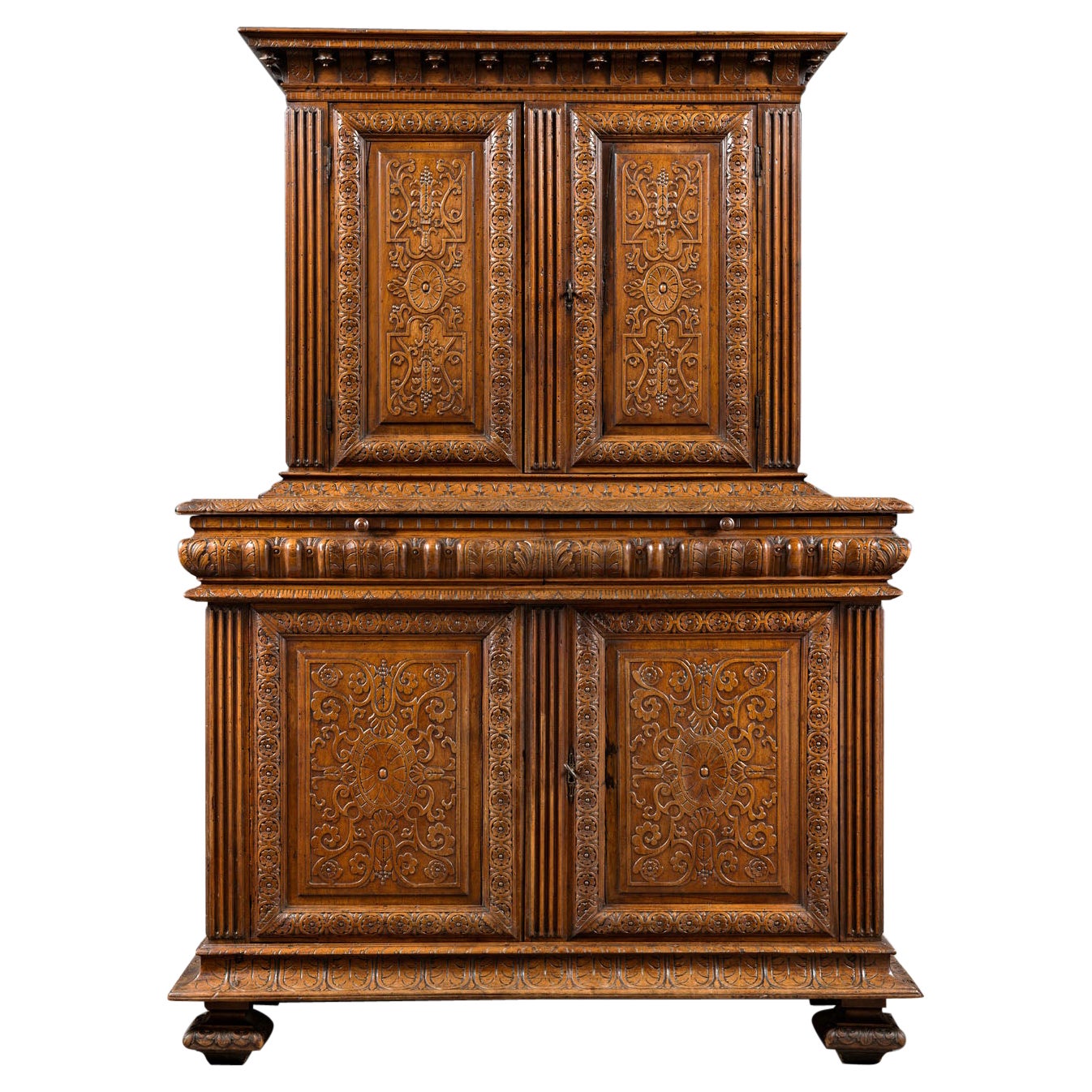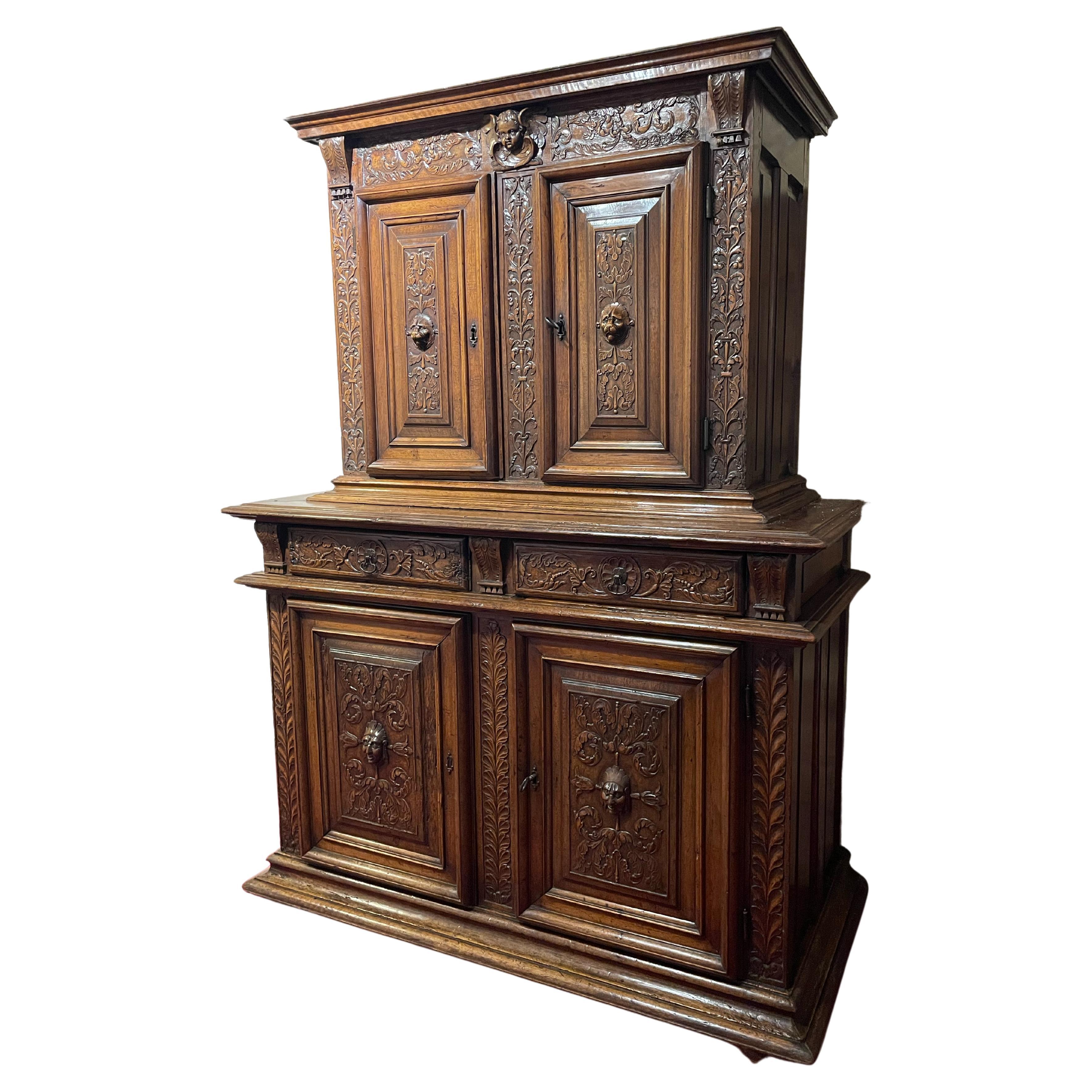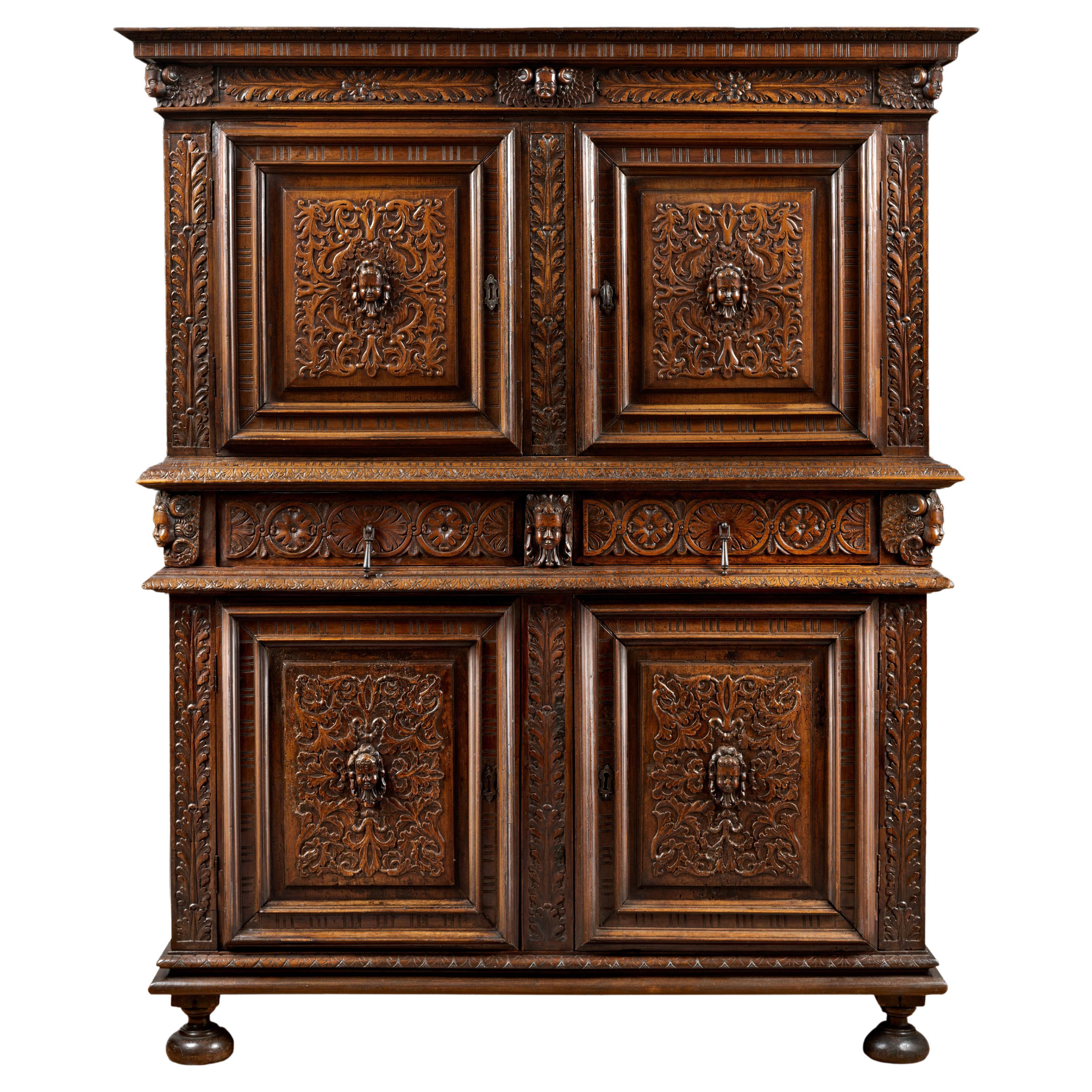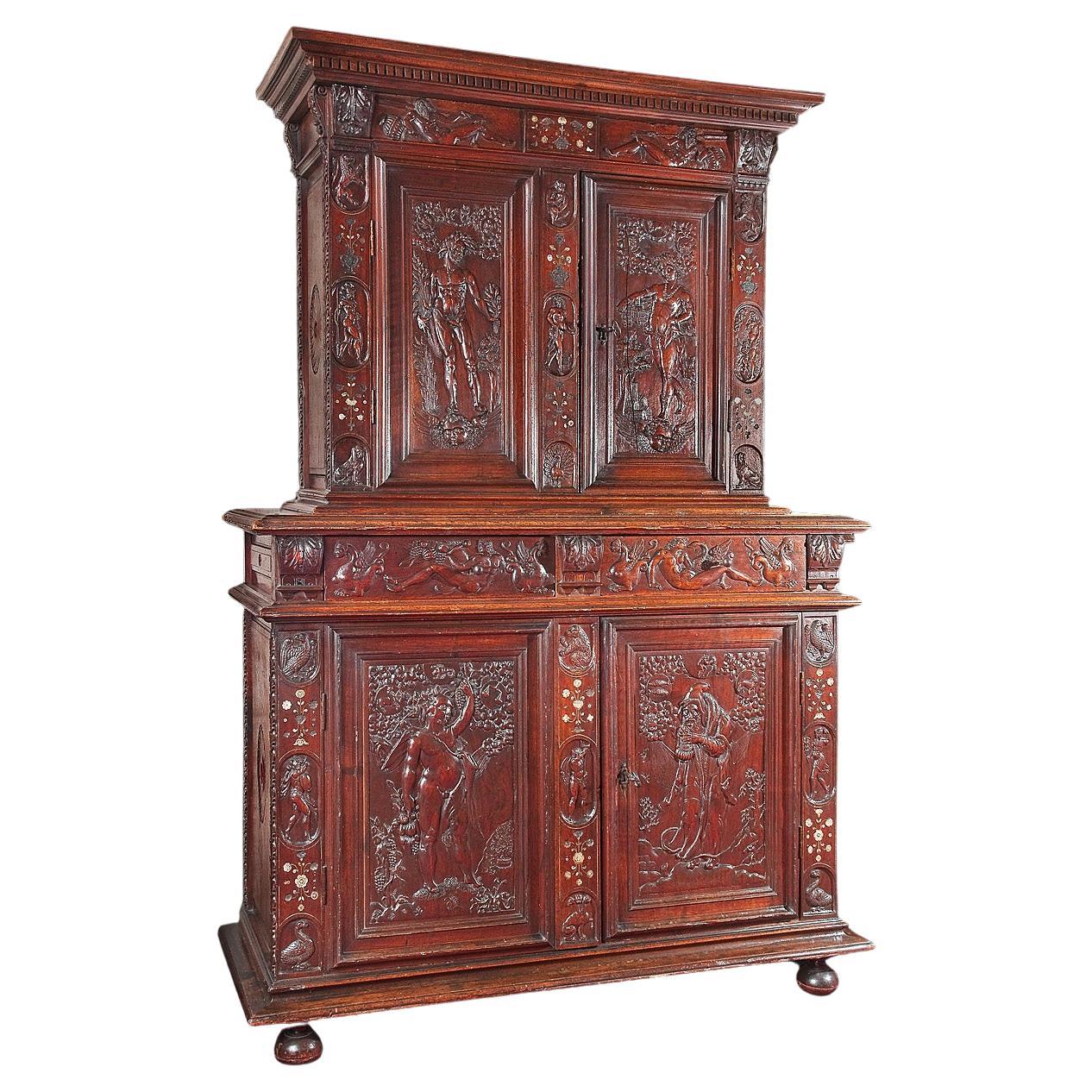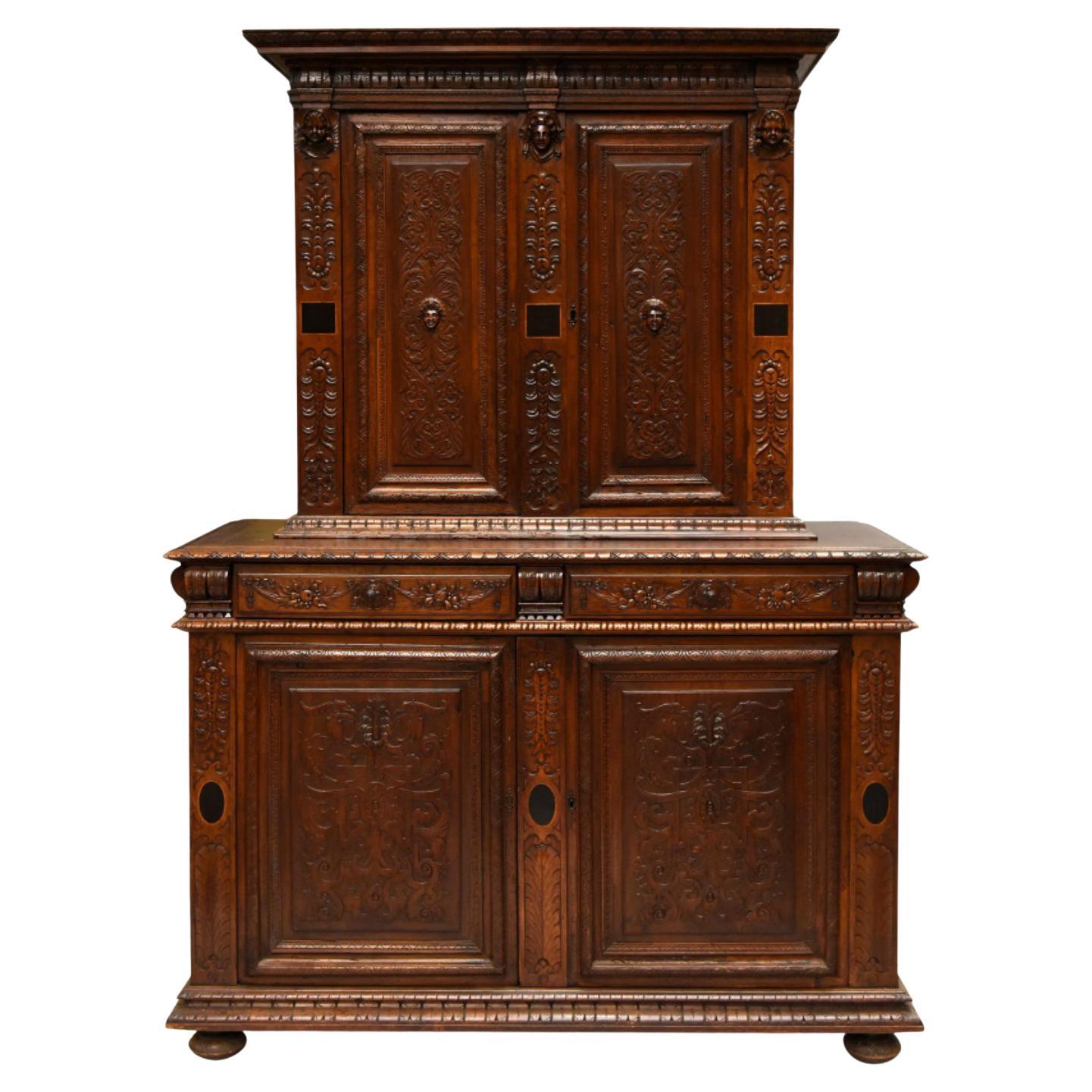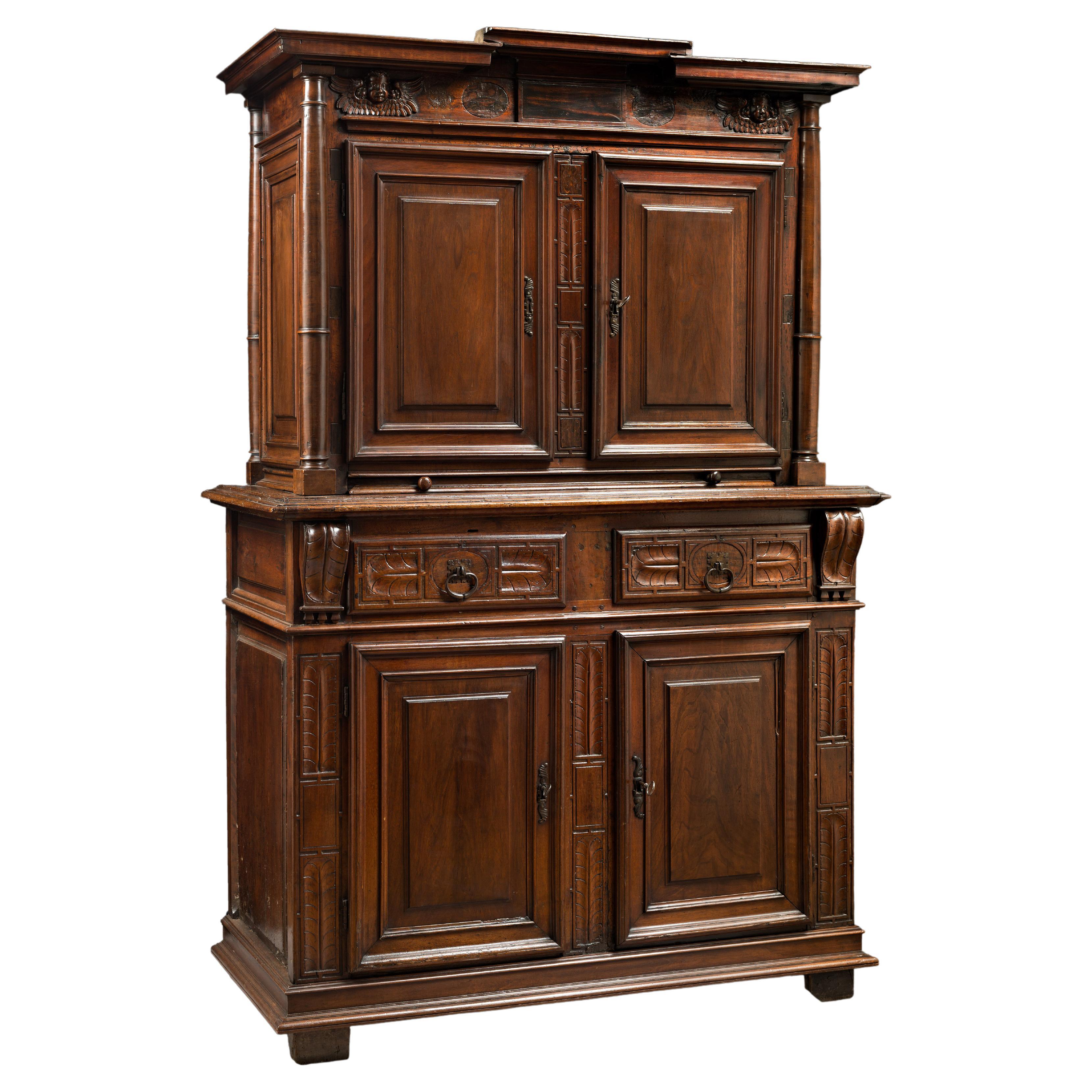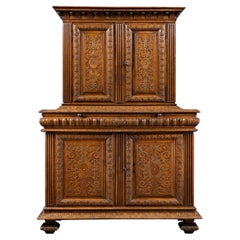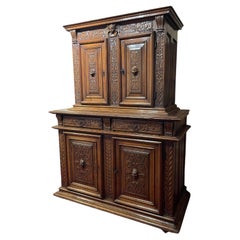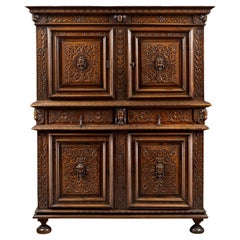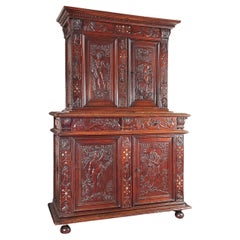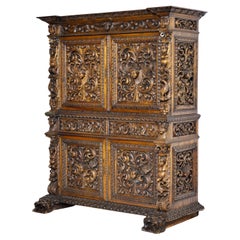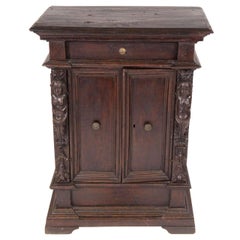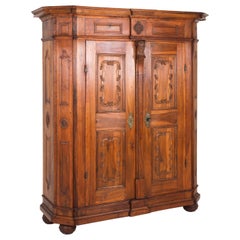Items Similar to Exceptional Cabinet known as the Sumene Cabinet
Want more images or videos?
Request additional images or videos from the seller
1 of 7
Exceptional Cabinet known as the Sumene Cabinet
$41,565.52
£30,770.41
€35,000
CA$57,267.27
A$63,803.82
CHF 33,308.61
MX$774,663.38
NOK 418,667.52
SEK 395,742.51
DKK 266,496.20
About the Item
EXCEPTIONAL CABINET KNOWN AS THE SUMÈNE CABINET
ORIGIN : FRANCE, NÎMES
PERIOD : 16th CENTURY
Height: 199 cm
Width: 180.5 cm
Depth: 69 cm
Walnut wood
Good state of preservation
This wardrobe is an example of the production that emerged in the small town of Sumène, in Lower Languedoc.
This production mainly consisted of wardrobes of this type, renowned for the beauty of their carved decorations, inspired at times by mythology or biblical narratives, and at other times adorned with abundant stylized flora. This particularly varied ornamental vocabulary originated from the research and rediscovery of Italian artists who drew their inspiration from antiquity.
This beautiful wardrobe is among those that could be found in the homes of the notables of the Lower Languedoc region in the late 16th century.
Rising on a molded base, the wardrobe's structure is constructed with tenons and mortises. The side posts and the false frame rise from the base. They are carved at their tops with lion masks, while elegant fruit drops adorn their entire length. The two doors of the wardrobe are divided into six panels surrounded by a molded frame and arranged in three registers. They are adorned with finely crafted flowers and stylized Burgundian cabbages.
A broad cornice covers the piece. The entablature is adorned with foliated scrolls and three heads of winged cherubs.
The harmonious proportions and skillfully executed decoration make this wardrobe a remarkable creation from the 16th-century Languedoc, a testament to a unique production in this region.
- Dimensions:Height: 78.35 in (199 cm)Width: 71.07 in (180.5 cm)Depth: 27.17 in (69 cm)
- Style:Renaissance (Of the Period)
- Materials and Techniques:
- Place of Origin:
- Period:
- Date of Manufacture:1500-1600
- Condition:Wear consistent with age and use.
- Seller Location:Saint-Ouen, FR
- Reference Number:Seller: 3251stDibs: LU3115341086452
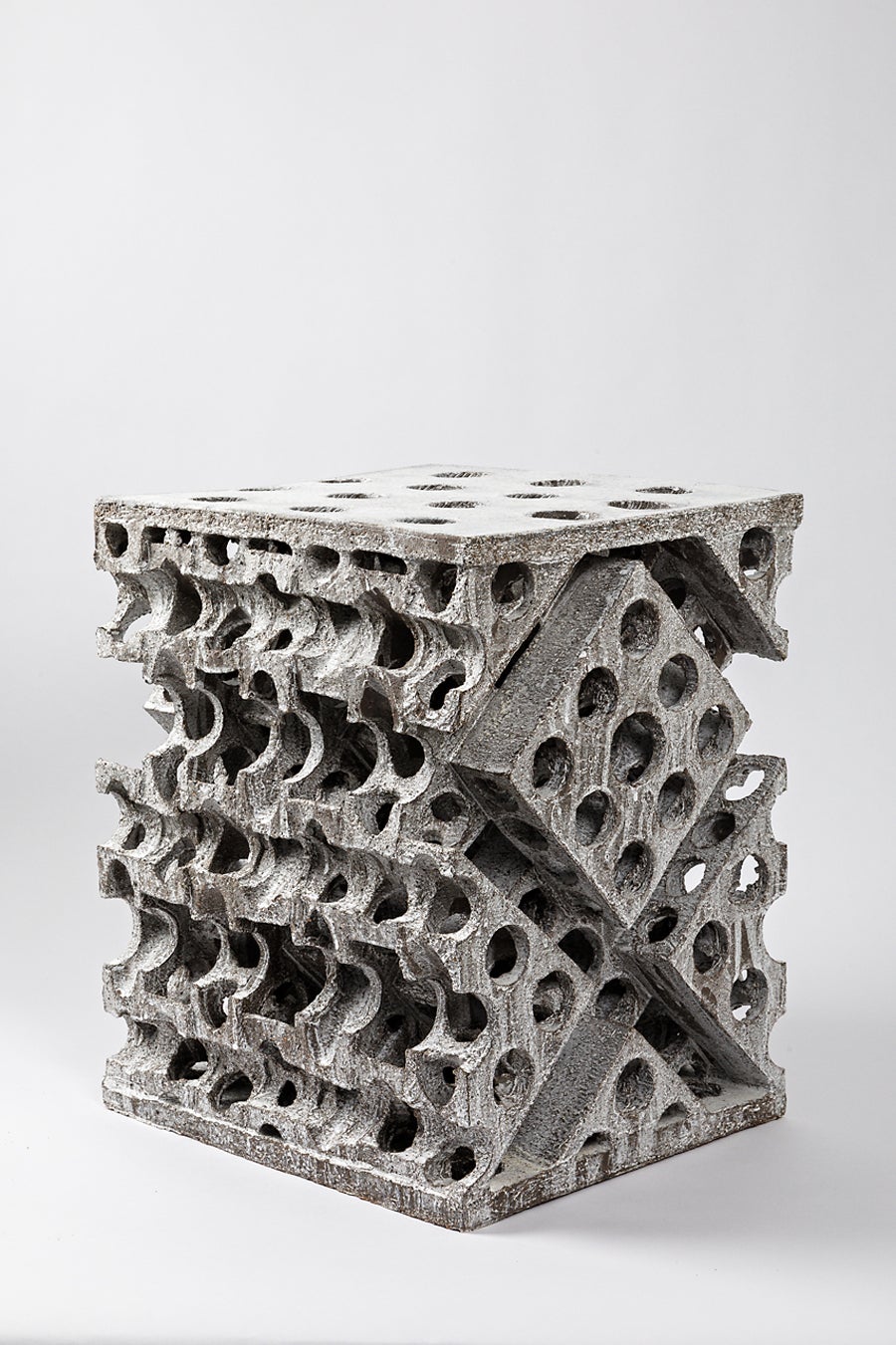
About the Seller
5.0
Vetted Professional Seller
Every seller passes strict standards for authenticity and reliability
Established in 2016
1stDibs seller since 2017
193 sales on 1stDibs
Typical response time: 1 hour
- ShippingRetrieving quote...Shipping from: Paris, France
- Return Policy
Authenticity Guarantee
In the unlikely event there’s an issue with an item’s authenticity, contact us within 1 year for a full refund. DetailsMoney-Back Guarantee
If your item is not as described, is damaged in transit, or does not arrive, contact us within 7 days for a full refund. Details24-Hour Cancellation
You have a 24-hour grace period in which to reconsider your purchase, with no questions asked.Vetted Professional Sellers
Our world-class sellers must adhere to strict standards for service and quality, maintaining the integrity of our listings.Price-Match Guarantee
If you find that a seller listed the same item for a lower price elsewhere, we’ll match it.Trusted Global Delivery
Our best-in-class carrier network provides specialized shipping options worldwide, including custom delivery.More From This Seller
View AllExceptional Renaissance Cabinet from Lyon
Located in Saint-Ouen, FR
Exceptional Renaissance Cabinet from Lyon
Origin: Lyon, France
Period: 1540-1580, Second French Renaissance
Measures: Height: 188 cm
Length: 132 cm
...
Category
Antique 16th Century Cabinets
Materials
Walnut
Small Renaissance Cabinet
Located in Saint-Ouen, FR
Small renaissance cabinet
ORIGIN : FRANCE
PERIOD : END OF THE 16th CENTURY
Measures: height: 167 cm
length: 123 cm
depth: 58 cm
This small two-part unit with harmonious proportions opens with four front leaves and two belt drawers. It rests on a molded base.
The uprights and the central frame of the lower body are adorned with long stylized palmettes. They frame the four leaves on which unfolds a vegetal decoration made of stems and leaves sculpted in symmetry around two mascarons topped with feathers...
Category
Antique 16th Century French Renaissance Cabinets
Materials
Walnut
$17,813
Small Renaissance Cabinet from Lyon
Located in Saint-Ouen, FR
Small renaissance cabinet from Lyon.
ORIGIN: FRANCE, SCHOOL OF LYON
PERIOD: 16th CENTURY
Height:151cm
Depth: 120cm
Length: 54cm
Walnut ...
Category
Antique 16th Century Cabinets
Materials
Walnut
Rare Renaissance Cabinet Richly Carved
Located in Saint-Ouen, FR
This rare Renaissance cabinet is richly decorated on the doors and drawers with carvings depicting the four seasons, and on the uprights and the entablature, alternating flower bouquets inlaid with mother of pearl. This is a beautifully conceived piece of furniture, representing a crowned portico with its entablature and cornice.
The upper body
Articulated separately in a ternary rhythm, as with the lower body, the upper part opens with two carved doors. The doors are framed by both the lateral uprights and the casing. There are cartouches carved into the casing in which mythological figures are depicted with flower bouquets.
On the doors:
On the right: Spring, a female figure crowned with a wreath of leaves, holding a basket full of flowers. She is wearing necklaces and bracelets on each arm, with drapery discretely wrapped around her body and is standing on a winged putti’s head. On each side are depicted a tree and a village with a steepled church. Above her head floats the three signs of the zodiac corresponding to the season: Aries, Taurus and Gemini.
On the left: Summer, a bearded man crowned with ears of corn and bearing armfuls of corn. He is standing on a similar winged putti, flanked by a tree and an ear of corn. The following three signs of the zodiac appear: Cancer, Leo and Virgo.
On the uprights and the central casing a number of smaller figures seem to represent virtues and vices that newly wedded couples should aspire to and avoid.
On each side, at the bottom of the uprights, there is a dog representing fidelity. Above, a lion embodies power, wisdom, and justice.
In between, on the left upright, there is a figure of noncombatant Athena wearing a helmet and holding a spear, an arrow pointing down and in her left hand, a shield, symbol of protective power. On the right upright, the goddess Venus controls the arrow of Cupid.
The iconography here acts as a clear reminder of the required virtues that both parts of a young couple need to fulfill: fidelity, power, wisdom and justice. For him, the goddess Athena focuses on the power. Whereas for her, it is Venus who shows how to control Cupid’s arrow.
On the central casing at the bottom, by way of contrast, there is a peacock, a symbol of pride and at the top, a monkey representing lust and mischief. In between, a woman holding a chain and a cup full of precious stones while on the floor sits a half empty opened casket. This can be interpreted as a symbol of extravagance.
Above, the entablature, decorated with male figures resting on leaking urns, may symbolize the passing of time. They are flanked by two consoles decorated with acanthus leaves and separated by flower bouquets (inlaid with mother of pearl). Finally on top, a cornice acts as a crown for the piece of furniture.
The lower body
The moulded base stands on four round, flattened feet.
Represented on the doors:
On the left: Autumn, a stocky, naked man crowned with vine leaves, holding fruits in his right hand and with his left, picking a bunch of grapes from a climbing vine. Standing on a mound, he is surrounded by a vine and a hill, at the foot of which a man presses the grapes in a big vat after the harvest. Above the climbing vine appear the signs of Libra, Scorpio and Sagittarius.
On the right: Winter, an elderly man wearing a fur cloak...
Category
Antique 16th Century French Renaissance Cabinets
Materials
Walnut
Renaissance Cabinet form Lyon 'France'
Located in Saint-Ouen, FR
Condition : Partly dating from the Renaissance. The backs and the drawer’s insides have been re-done.
Historical background
The 16th century is a prosperous period for Lyon...
Category
Antique 16th Century French Renaissance Cabinets
Materials
Walnut
16th Century Renaissance Two-Bodied Cabinet
Located in Saint-Ouen, FR
Former collection Altounian
At the beginning of the reign of Henri II (1547-1559) the furniture’s ornamentation evolves. The few medieval motifs that were still used are eventually relinquished. Furniture becomes more sober showcasing moulded panels and perfect architecture. Cabinet-makers use ornaments such as curved fluted or plain columns, feather quills, roses or winged putti heads. High-relief carving becomes more scarce and compositions lighter. To that end cabinet-makers draw inspiration from Fontainebleau motifs filtering them and adapting them to French taste.
During this period cabinet-makers turn into a kind of architects. Indeed the architectural balance of furniture is the centre of their concerns. The study of Antic formulas is then a necessity. From this care given to proportions appear refined cabinets with pure lines.
This style is characteristic of the reign of Henri II and disappears soon after under the regency of Catherine de Medici (1560-1574) when an abundance of high and low-relief ornaments comes back on furnitures.
This two-bodies cabinet...
Category
Antique 16th Century French Renaissance Cabinets
Materials
Walnut
You May Also Like
RENAISSANCE TWO BODY CABINET 19th Century
Located in Madrid, ES
RENAISSANCE TWO BODY CABINET 19th Century
In oak wood
Upper part with two profusely carved doors.
Lower part with two drawers and two doors.
Decorated with plant motifs, zoomorphic ...
Category
Antique 19th Century Portuguese Baroque Cabinets
Materials
Wood
$8,835 Sale Price
20% Off
Italian Renaissance Style Cabinet
Located in Sheffield, MA
Small in size but impressive in the scale of its architectural moldings and details, this Italian Renaissance-style cabinet contains two shelves b...
Category
Antique 19th Century Italian Jacobean Cabinets
Italian Renaissance Style Cabinet
Located in Sheffield, MA
Small in size but impressive in the scale of its architectural moldings and details, this Italian Renaissance-style cabinet contains two shelves behind double paneled doors and a cen...
Category
Antique 19th Century Italian Jacobean Cabinets
Baroque Cabinet, Mid-18th Century
Located in Greding, DE
Two-door baroque cabinet with profiled plinth and cornice as well as coffering on all sides. The pilasters are bevelled. A quatrefoil cartouche with monogram EWTS and rubbed date (17...
Category
Antique Mid-18th Century European Baroque Cabinets
Materials
Iron
Neo-Renaissance Cabinet, Late 19th Century
Located in Greding, DE
A four-door cabinet in Renaissance style standing on ball feet with lion's head mascarons and half-columns with volute capitals. The doors with panels and vine decoration are separat...
Category
Antique 19th Century German Renaissance Revival Cabinets
Materials
Wood
18th Century Dutch Renaissance Cabinet
Located in Casteren, NL
Dutch Renaissance cabinet with two doors and one drawer.
Made from solid oakwood with mahogany veneer.
This cabinet has a rare and authentic ...
Category
Antique Early 18th Century Dutch Cabinets
Materials
Oak
More Ways To Browse
Fruit Cabinet
Lion Head Cabinet
Cherub Cabinet
Antique Cherub Cabinet
Fruit Wood Cabinet
Small Antique Wardrobes
16th Century Italian Walnut
16th Century Italian Cabinet
Beautiful Antique French Wardrobe
Walnut Carved Lions Head
16th Renaissance Walnut Italian
Wardrobe With Flowers
Flora Cabinet
16th Century Carved Cherub
Fruit Cabinet
Twins Cabinet
Two Piece China Cabinet
Used Exterior Wood Doors
